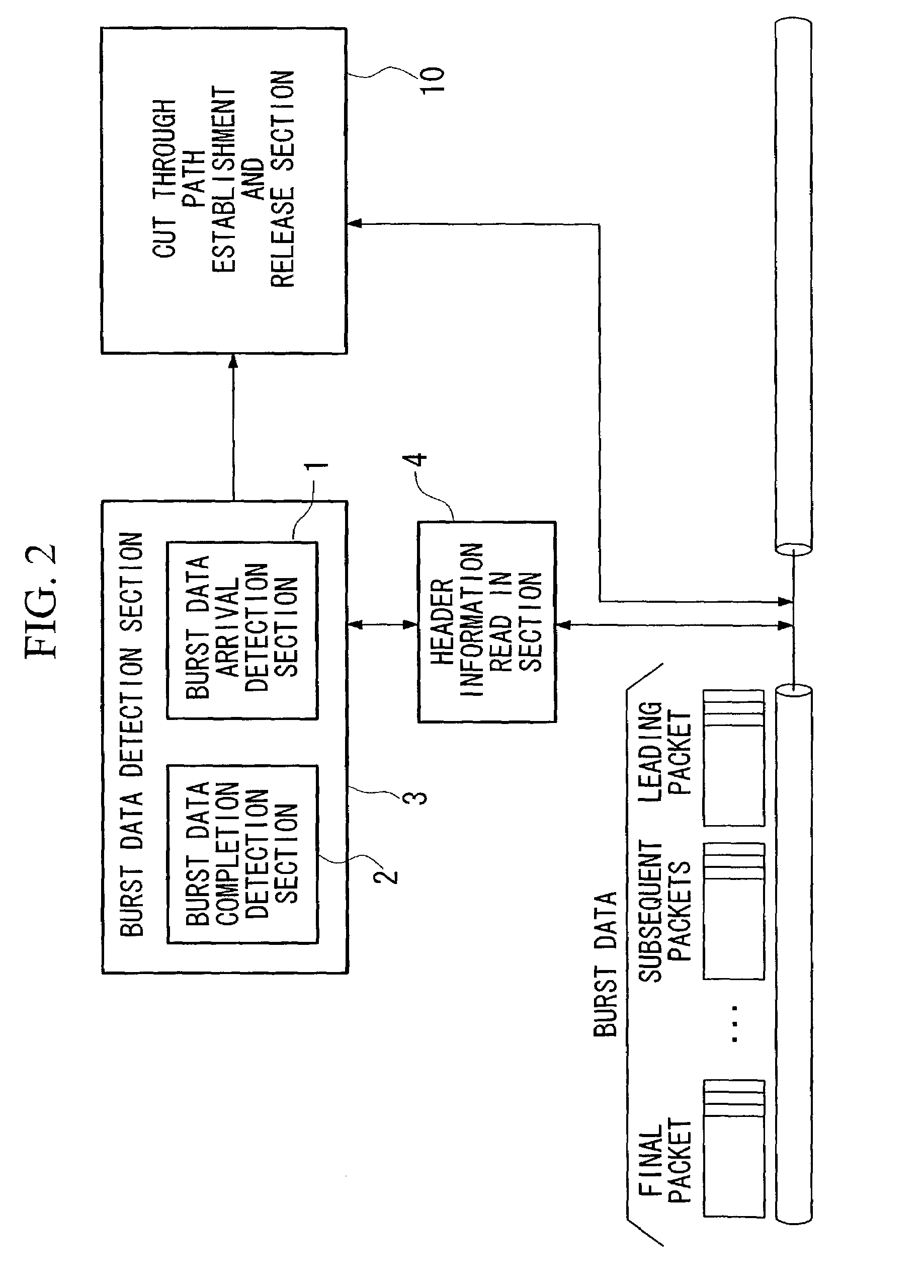Optical dynamic burst switch
a dynamic burst switch and optical technology, applied in the field of optical dynamic burst switch, can solve the problems of requiring a certain time period, requiring a large amount of time for this type of setting procedure, and inefficient burst data transfer by individual ip packet units, so as to reduce labor and time period, achieve efficient network resources, and perform burst data transfer reliably
- Summary
- Abstract
- Description
- Claims
- Application Information
AI Technical Summary
Benefits of technology
Problems solved by technology
Method used
Image
Examples
embodiment 1
[0192]An optical communication network according to the first embodiment of the present invention will now be explained with reference to FIGS. 1 through 7. FIG. 1 is a schematic diagram showing an optical communication network according to an embodiment of the present invention; FIG. 2 is a diagram for explanation of a burst data detection section and a cut through path establishment and release section of the first embodiment of the present invention; FIG. 3 is a diagram showing the structure of a packet which is used in the embodiments of the present invention; FIG. 4 is a block diagram for a burst data arrival detection section of the first embodiment of the present invention; FIGS. 5 and 6 are flow charts showing the operation for dynamically setting a limit value, with the first embodiment of the present invention; and FIG. 7 is a diagram for explaining a data base of the first embodiment of the present invention.
[0193]As shown in FIG. 1, the present invention is an optical co...
embodiment 2
[0208]The second embodiment of the present invention will now be explained with reference to FIGS. 8 and 9. FIG. 8 is a block diagram for a burst data detection section and a cut through path establishment and release section of the second embodiment of the present invention. And FIG. 9 is a flow chart showing the operation of the cut through path establishment and release section of this second embodiment of the present invention.
[0209]In this second embodiment, as shown in FIG. 8, the cut through path establishment and release section 10 comprises an L1 retaining section 11 which retains burst lengths L1 which represent burst data amount information relating to the burst data which is being transferred by the cut through paths which are already established; and, as shown in FIG. 9, when there are no wavelength resources for newly establishing a cut through path to transfer newly arrived burst data, the burst lengths L1 of the burst data which is being transferred by the already es...
embodiment 3
[0214]The third embodiment of the present invention will now be explained with reference to FIGS. 10 and 11. FIG. 10 is a block diagram for a burst data detection section and a cut through path establishment and release section of the third embodiment of the present invention. And FIG. 11 is a flow chart showing the operation of the cut through path establishment and release section of this third embodiment of the present invention.
[0215]In this third embodiment, the cut through path establishment and release section 10 comprises an Lreg detection section 12 which, when there are no wavelength resources for newly establishing a cut through path to transfer newly arrived burst data, detects not yet transferred burst lengths Lreg which represent the not yet transferred burst data amounts of the burst data which is being transferred by the cut through paths which are already established, and, if according to the results of detection by the Lreg detection section 12 the not yet transfer...
PUM
 Login to View More
Login to View More Abstract
Description
Claims
Application Information
 Login to View More
Login to View More - R&D
- Intellectual Property
- Life Sciences
- Materials
- Tech Scout
- Unparalleled Data Quality
- Higher Quality Content
- 60% Fewer Hallucinations
Browse by: Latest US Patents, China's latest patents, Technical Efficacy Thesaurus, Application Domain, Technology Topic, Popular Technical Reports.
© 2025 PatSnap. All rights reserved.Legal|Privacy policy|Modern Slavery Act Transparency Statement|Sitemap|About US| Contact US: help@patsnap.com



